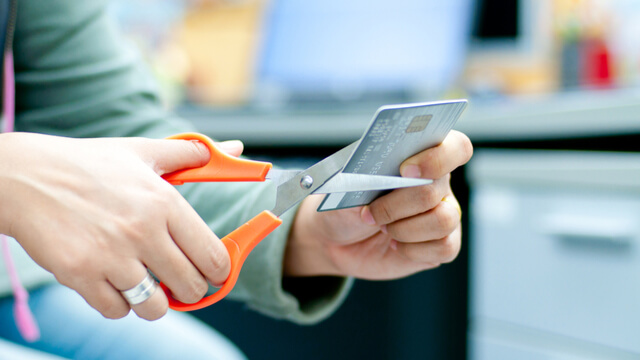We are increasingly a cashless society. According to the latest figures, card transactions are the most popular way for Kiwis to pay. Last year, we spent $92.9bn on our credit and debit cards. And September’s numbers show that the total value of electronic card spending was up $238m (3.2%) compared with September 2019.
But with this rise in spending comes an increased risk of credit card fraud, especially online, where scams and fraud have been on the rise. And if you only check your credit card statement once a month, it could be weeks before you discover a seemingly unauthorised transaction has been made on your credit card.
While your initial reaction might be alarm. Don’t panic. There are steps you can take to get the fraudulent transaction reversed. Here’s what you can do:
1. Make sure the transaction was actually unauthorised
Initially, sometimes a transaction can look unfamiliar and, therefore, suspicious, depending on the name listed against it. If you don’t recognise a transaction, compare the fee charged and the date with your other records before reporting it as unauthorised.
Sometimes store-front names are very different from company trading names. And if you’re purchasing goods or services online, your payment could be routed through an overseas payment platform with a different name altogether.
2. Lock or cancel your credit card
If a fraudster has your details and has made an unauthorised transaction on your credit card, they could more – unless you take swift action.
After discovering a genuinely unauthorised transaction, you can usually either temporarily lock or permanently cancel the credit card in question. If your bank offers you the option of temporarily locking your credit card, you may find that a more convenient option than fully cancelling the card and having to wait for a replacement.
However, it may be worth keeping in mind that if the card has been compromised by fraudulent activity, it may be best to cancel it. Otherwise, you could leave yourself vulnerable to further unauthorised transactions.
As well as the option of contacting your bank, Visa and Mastercard also each have their own facilities for reporting fraudulent transactions. They can lock or cancel your card, and notify your bank or financial institution of the fraudulent activity on your behalf.

3. Alert your bank/financial institution
Once you’ve either locked or cancelled your credit card in order to prevent any further fraudulent activity, you should immediately alert your bank or financial institution. It may be best to do this by phone, as it could be easier and quicker than communicating by email or through a mobile banking app.
Your bank will typically investigate the transaction and, if it’s satisfied that it’s genuinely fraudulent, may be able to reverse the transaction and refund your account.
Note that some transactions may take longer than others for your bank to assess, and the process could take up to a month. Once your bank has determined the outcome of their investigation, they will usually notify you by letter or email.

However, you are unlikely to get your money back from an unauthorised transaction if you:
- Acted fraudulently yourself
- Haven’t keep your PIN or password secret
- Didn’t inform your financial institution that your card was lost or stolen or that someone else potentially knew your PIN or password in a timely manner
- Haven’t reasonably safeguarded your mobile phone if you’re using a mobile wallet
4. Check and change your online banking log-in details
While a criminal doesn’t need access to your online or mobile banking in order to make fraudulent transactions on your credit card, it’s still prudent to change your password or passwords just in case.
What if the transaction was a mistake, but not unauthorised?
There are some situations in which you may be able to get your money back even if you made or authorised the transaction. For example, if you incorrectly entered a BSB or account number when making a payment, you will generally be able to obtain a refund if you contact your financial institution.
According to the Banking Ombudsman, banks can reverse a payment made mistakenly, but only with the consent of the person who received it. Your bank and their bank will need to co-operate to try to recover the payment. Usually, this involves the recipient’s bank contacting their account holder to ask their permission to reverse the transaction.
The process is easier if you discover your child has made an unauthorised purchase at an online app store, such as Apple’s. It’s a simple process to have the store delete the app and refund your money.
What is fraud protection and which credit cards offer it?
Fraud protection is a feature that generally comes with all Visa and Mastercard cards, from low-rate and low-free cards to premium and rewards cards, as well as some cards from other providers.
Both Visa and Mastercard have Zero Liability policies in place, which protect credit card customers against unauthorised transactions and fraudulent activity. These policies generally mean customers aren’t held responsible for unauthorised transactions made using their credit card(s).
In addition, some banks have separate fraud prevention measures in place, such as 24/7 monitoring to help detect suspicious transactions. Consider checking what additional security is on offer from providers if you are comparing credit cards. But remember that some security features a provider offers may only be available on certain cards.
If you’re addicted to your fantastic plastic, in addition to considering card security, have you taken time recently to work out if you have the right card to suit your spending profile?
Are you using a rewards card when it would make more sense to have a low-interest one? Could you be getting better cash-back returns? If you already know the type of new credit card you’re after, or are considering switching, you can use Canstar’s free credit card search tools to narrow down and compare your options. Just follow the link below.
Compare credit cards with Canstar
Enjoy reading this article?
You can like us on Facebook and get social, or sign up to receive more news like this straight to your inbox.
By subscribing you agree to the Canstar Privacy Policy




Share this article